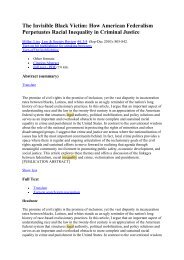Ski – resort and regional development: profile of visitors ... - E-Journal
Ski – resort and regional development: profile of visitors ... - E-Journal
Ski – resort and regional development: profile of visitors ... - E-Journal
Create successful ePaper yourself
Turn your PDF publications into a flip-book with our unique Google optimized e-Paper software.
110<br />
Garyfallos Arabatzis, Serafeim Polyzos <strong>and</strong> Stavros Tsiantikoudis<br />
for the tourism <strong>development</strong> <strong>of</strong> an area <strong>and</strong> the imposition <strong>of</strong> essential limits. Thus, the tourism<br />
does not lead to the degradation <strong>of</strong> the environment <strong>and</strong> in long-terms to the tourist disdain<br />
<strong>of</strong> an area, but in its protection or its conservation. In other words, the environment influences<br />
the tourism <strong>and</strong> vise versa. The environment <strong>of</strong> a region is negatively influenced most times<br />
by the increase <strong>of</strong> tourism, whereas the <strong>development</strong> <strong>of</strong> tourism depends on the quality <strong>and</strong><br />
the characteristics <strong>of</strong> the environment (Brown et al. 1997).<br />
Tourism as an economic activity has contributed extremely to the <strong>development</strong> <strong>of</strong> many<br />
geographically isolated regions <strong>of</strong> Greece as well as <strong>of</strong> other countries helping in this way<br />
in spatial diffusion <strong>of</strong> the <strong>development</strong> <strong>and</strong> creating the conditions for <strong>regional</strong> <strong>development</strong>.<br />
In the last years the abrupt <strong>and</strong> lacking <strong>of</strong> organization tourism <strong>development</strong> <strong>of</strong> many regions<br />
<strong>of</strong> Greece in combination with the massiveness <strong>of</strong> tourism causes new problems in the<br />
organisation <strong>of</strong> <strong>regional</strong> space. As main reasons can be reported: (a) <strong>regional</strong> inequalities<br />
because <strong>of</strong> the excessive concentration <strong>of</strong> tourism in specific areas, (b) progressive ab<strong>and</strong>onment<br />
<strong>of</strong> other productive activities <strong>and</strong> the appointment <strong>of</strong> tourism as the only or main activity in<br />
a number <strong>of</strong> regions <strong>and</strong> (c) the degradation <strong>of</strong> the allocated tourism resources <strong>and</strong> the reduction<br />
<strong>of</strong> tourist attractiveness <strong>of</strong> an area due to the overexploitation <strong>of</strong> the natural <strong>and</strong> structured<br />
environment.<br />
The problem <strong>of</strong> the determination <strong>of</strong> the tourism capacity <strong>of</strong> a mountainous area such as the<br />
Plastira’s Lake area, <strong>and</strong> the potential <strong>of</strong> tourism <strong>development</strong> are analyzed in the present<br />
paper.<br />
The Plastira's Lake area can be characterized as geographically isolated <strong>and</strong> problematic as<br />
far as <strong>development</strong> is concerned, with serious demographic problems, with lacks in the<br />
technical infrastructure <strong>and</strong> economic activities <strong>of</strong> low productivity. The area allocates<br />
particularly natural characteristics, a fact that contributed decisive in the <strong>development</strong> <strong>of</strong><br />
tourism in the last years. The natural environment is presented particularly considerable in<br />
<strong>development</strong> <strong>of</strong> the area through a frame <strong>of</strong> <strong>development</strong> compatible with the protection <strong>of</strong><br />
nature.<br />
Despite its natural beauty the lake area had not been considered as an important resource for<br />
the local communities until 1988; then a local <strong>development</strong> plan by the Prefecture authorities<br />
indicated agro-tourism as an alternative path to <strong>development</strong>. Afterwards, the communities<br />
took the initiative to build 7 hostels that first operated around the mid 90’s. This was followed<br />
by increasing numbers <strong>of</strong> <strong>visitors</strong> in the area (Koutsouris, 2002).<br />
The tourist dem<strong>and</strong> in the area increased very rapidly in the 90s <strong>and</strong> continues to increase<br />
with a lower rate. Concretely, an increase <strong>of</strong> arrivals <strong>and</strong> overnight stays by 440% <strong>and</strong> 425%<br />
respectively, was noticed in the 1995-1997 period which consists in the majority <strong>of</strong> local <strong>and</strong><br />
less by foreign <strong>visitors</strong>. In the 1997 <strong>–</strong> 1999 we have a continuing increase in the total <strong>of</strong><br />
arrivals <strong>and</strong> overnight stays, at 51,76% <strong>and</strong> 43,15% respectively. The overnight stays were<br />
Tourism Today - Fall 2007 - Full Paper














